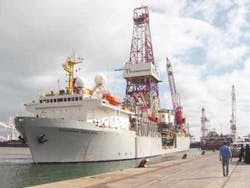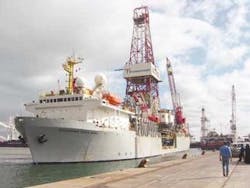India gambles on deepwater play
M. Singh Gandhi
Special Correspondent
The drillship Vijay Sagar has tested natural gas at a depth of 428 m in its first deepwater test of a new major campaign, in the Krishna Godavari basin in Indian waters. It is the first discovery in an ambitious deepwater drilling program called Sagar Samriddhi, launched late last year by India's Oil and Natural Gas Commission Ltd.
The discovery came at well G4- AB, off the coast of Yanam about 38 km from nearest landfall. The discovery is in a strati-structural feature with multiple stacked sand bodies within a Pliocene channel-fan complex.
The well encountered a net 56 m of hydrocarbon-bearing sands at 1,650-2,130 m. Five zones have been identified, of which the first has been tested at flow rates of 14.42 MMcf/d, through a 1/2-in. choke.
The first well in the KG basin raises hopes for similar hits. ONGC officials maintain that there are exciting prospects in the KG basin.
Under the project, begun in August 2003, ONGC has earmarked a daily investment of $750,000. Described as the biggest deepwater exploration campaign undertaken by a single operator anywhere in the world, the program calls for a total of 47 deepwater wells, the deepest to be drilled in 6,000 m of water. This would be a remarkable feat by any standard, given that the deepest water record so far is at 10,011 ft in the US Gulf of Mexico.
The preparation for the Sagar Samriddhi campaign triggered a series of new processes and acquisition of new infrastructures by ONGC. Under the new risk-sharing model, ONGC makes a daily payment to the contractor.
Though the investment is heavy ($300,000 per day for one rig), the team is gaining knowledge about deepwater drilling technology. A few years hence, not only will ONGC be in a position to undertake deepwater drilling, but also it could take up similar operations in other deepwater oil markets, such as West Africa and Thailand.
The first Sagar Sanriddhi well, spudded in September at G 42, is located in the Krishna Godavari basin off the Andhra coast. Two other drilling units have been deployed – the Belford Dolphin and the Discover Seven Seas. For the moment, attention is focused on the Belford Dolphin. The vessel, equipped with DP3 classification, is drilling at water depths of 1,850 m in block GK-A-A in the Gulf of Kutch, about 180 km northwest of Porbandar on the west coast of India. The well, spudded in November 2003, is the second of the 47 deepwater wells planned.
null
The Discoverer Seven Seas began drilling in February as part of the ONGC deepwater program off India.
The objective of the well is to probe the carbonate body that has an aerial extent of 50 sq km. The secondary objective is to probe the Mesozoic sediments underlying the Deccan Traps.
India currently meets only 30% of its domestic demand for oil and gas. According to government figures, by 2025 demand for oil will be 365 million tonnes and for gas 200 billion cu m per annum. While on the one hand demand for oil and gas is expected to grow 10-fold by 2025, on the other hand shallow reserves of oil and gas that have been the chief source of supply are being depleted. Decision-makers in India see deepwater exploration as the future of the Indian oil industry.
India has a deepwater area of 1.35 million sq km. Four deepwater potential fields have been identified. The coastal basins of Krishna Godavari, Cauvery, and Mumbai High continue into deepwater and another potential reserve lies off the Andaman Islands, contiguous to the hydrocarbon-rich basins of Burma and Thailand.
The Krishna Godavari offshore basin is believed to have the best prospects, and it is not surprising that ONGC has kicked off its deepwater drilling exploration in this region.
According to Subir Raha of ONGC, "By 2020, of the additional 6 billion tonnes of equivalent oil, 4 billion will come from the deepwater basin."
The investment required is heavy for a developing country like India, but the official justification is that one good discovery will offset the cost.
"In normal wells we might expect 1,000-5,000 b/d, whereas in deepwater, we are talking about 10,000-20,000 b/d," said UN Bose of ONGC.
India's deepwater drilling campaign is headed by Subir Raha, who took over as its C&MD in May 2001. He started preparing for the deepwater campaign early last year. He set up several interactive sessions with the various departments of ONGC and with the representatives of the global deepwater industry. He added special teams comprised of geologists, geophysicists, and geochemists and began extensive 2D and 3D seismic surveys.
The current plan calls for 21 wells to be drilled off the west coast of India and 11 off the east coast. This schedule could change, depending on the exploration results. After a 2D survey of nearly 20,000 line km and a 3D survey of 97,000 sq km, ONGC is doing a further survey of 14,000 line km of 2D and 18,000 sq km of 3D survey.

